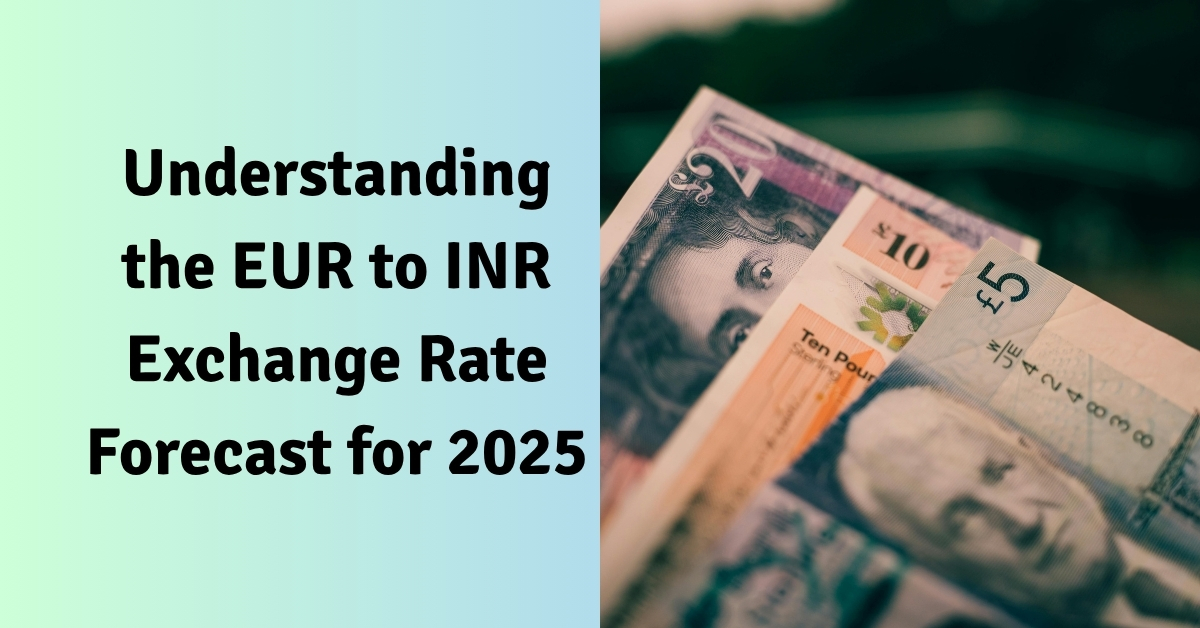Understanding the EUR to INR Exchange Rate Forecast for 2025
Currency fluctuations can significantly impact your travel budget, business costs, or investment returns. Whether you’re planning a European vacation, importing goods from the Eurozone, or managing international investments, understanding the EUR to INR exchange rate trajectory is crucial for making informed financial decisions.
This comprehensive analysis examines the EURO to INR exchange rate forecast for 2025, exploring market dynamics, expert predictions, and practical implications for various stakeholders.
Understanding EUR to INR Exchange Rate Dynamics
The Euro to Indian Rupee exchange rate operates in a complex ecosystem influenced by multiple interconnected factors. Unlike fixed exchange rates, the EUR/INR pair fluctuates continuously based on economic fundamentals, market sentiment, and global events.
Economic Fundamentals
Monetary Policy Divergence The European Central Bank (ECB) and Reserve Bank of India (RBI) monetary policies create the foundation for currency movements. Interest rate differentials between the two regions drive capital flows, with higher rates typically attracting foreign investment and strengthening the respective currency. This is a key reason why the euro to INR is increasing in 2025, as the ECB maintains a tighter policy stance.
Growth and Inflation Dynamics: GDP growth rates and inflation levels in both regions significantly influence currency valuations. Strong Eurozone economic performance relative to India tends to strengthen the Euro, while superior Indian growth can boost the Rupee. Inflation differentials also play a crucial role – higher inflation in one region typically weakens its currency relative to the other.
Trade and Current Account Balance The trade relationship between the Eurozone and India, along with their respective current account positions, affects currency demand. A stronger trade surplus or improved current account balance generally supports currency strength.
Political and Regulatory Environment
Policy Stability Political stability and policy predictability in both regions influence investor confidence and currency strength. Elections, policy changes, and regulatory shifts can create volatility in exchange rates.
Geopolitical Factors International relations, trade agreements, and global geopolitical events impact currency movements through their effects on investor sentiment and capital flows.
Global Market Influences
Risk Sentiment Global risk appetite affects emerging market currencies like the Rupee more than developed market currencies like the Euro. During risk-off periods, investors typically favor safer assets, potentially strengthening the Euro relative to the Rupee.
Commodity Prices Oil and commodity price movements significantly impact India’s current account balance and inflation, indirectly affecting the Rupee’s strength against the Euro.
Want the latest exchange rates at your fingertips? Click here to access Live Euro-INR Currency Converter and make smarter financial decisions.
Current Market Analysis and 2025 Outlook
Present Market Conditions
As of July 2025, the EUR/INR exchange rate trades around ₹100.50-101.00, representing a significant recovery from early 2025 levels. The Euro has demonstrated resilience, climbing from approximately ₹88.09 in January 2025 to current levels, marking a substantial appreciation of over 14%.
Expert Forecasts and Euro INR Prediction
Leading Analyst Predictions:
CoinCodex provides the most comprehensive forecast, projecting the EURO TO INR to trade between ₹101.01 and ₹121.12 throughout 2025, with an average expected rate of ₹110.96. Their analysis suggests continued Euro strength driven by ECB policy support and relative economic performance.
Traders Union offers a more conservative outlook, estimating the EUR/INR at ₹100.74 by year-end 2025, indicating modest appreciation from current levels.
BookMyForex’s technical analysis suggests near-term targets of ₹100.78 for October 2025 and ₹100.12 for November 2025, reflecting some potential volatility in the coming months.
Market Sentiment Indicators: Technical analysis across multiple timeframes shows “Buy” signals for the EUR/INR pair, suggesting continued bullish momentum. However, this should be balanced against fundamental analysis and risk factors.
Historical Performance Context
2025 Performance Review:
- January 2025: ₹88.09 (year opening)
- June 2025: ₹98.23 (mid-year strength)
- Peak 2025: ₹101.04 (highest recorded)
- Average 2025: ₹94.15 (year-to-date)
This trajectory demonstrates the Euro’s recovery from previous weakness and aligns with broader European economic resilience.
Scenario Analysis for Remainder of 2025
Optimistic Scenario (Probability: 30%)
Target Range: ₹110-120 by December 2025
Key Drivers:
- Strong Eurozone economic growth outpacing India
- Continued ECB policy tightening
- Improved European energy security
- Stable global risk sentiment
Implications:
- Favorable for Indian students studying in Europe
- Higher costs for Indian importers from the Eurozone
- Potential headwinds for Indian IT services exports to Europe
Base Case Scenario (Probability: 50%)
Target Range: ₹102-108 by December 2025
Key Drivers:
- Moderate European growth with stable inflation
- Balanced monetary policy approach from both the ECB and the RBI
- Steady global economic conditions
- Gradual normalization of trade patterns
Implications:
- Manageable impact on most cross-border transactions
- Continued gradual appreciation trend
- Balanced environment for trade and investment
Pessimistic Scenario (Probability: 20%)
Target Range: ₹95-100 by December 2025
Key Drivers:
- European economic slowdown or recession
- Aggressive RBI tightening with ECB pause
- Global risk-off sentiment
- Geopolitical tensions affecting European stability
Implications:
- Benefits for Indian importers and travelers to Europe
- Potential pressure on Euro-denominated investments
- Challenging environment for European exporters to India
Conclusion: Navigating the EUR to INR Exchange Rate in 2025
The EUR to INR exchange rate forecast for 2025 suggests continued Euro strength, with most analysts expecting the pair to trade between ₹100-110 for the remainder of the year. The base case scenario points to gradual appreciation driven by relative economic performance, monetary policy dynamics, and improving European fundamentals.
However, currency markets remain inherently unpredictable, and multiple scenarios remain possible. Success in navigating these fluctuations requires continuous monitoring of key indicators, robust risk management strategies, and flexibility to adapt to changing market conditions.
Whether you’re a business owner, investor, or individual consumer, understanding these dynamics and preparing for multiple outcomes will help you make more informed financial decisions in an uncertain global environment.
Frequently Asked Questions
1. What is the most likely EUR to INR exchange rate by December 2025?
Ans – Based on current analysis, the most probable range is ₹102-108, with an average expectation around ₹105-106. This represents continued gradual appreciation from current levels.
2. How reliable are currency forecasts for making financial decisions?
Ans – Currency forecasts provide directional guidance but should not be the sole basis for financial decisions. They’re best used as one input among many, combined with proper risk management and diversification strategies.
3. What economic indicators should I monitor for EUR/INR movements?
Ans – Key indicators include ECB and RBI policy decisions, GDP growth rates, inflation data, trade balances, and global risk sentiment measures. Central bank communications are particularly important for understanding policy direction.
4. How can businesses hedge against EUR/INR volatility?
Ans – Businesses can use forward contracts, currency options, natural hedging through operational adjustments, or netting strategies. The choice depends on the specific exposure, risk tolerance, and cost considerations.
5. Is now a good time to convert INR to EUR for travel or education?
Ans – Given the current appreciation trend, there may be merit in gradual conversion rather than waiting. However, individual circumstances vary, and systematic approaches often work better than timing attempts.
6. How do global events affect the EUR/INR exchange rate?
Ans – Global events impact the pair through risk sentiment, capital flows, and economic spillovers. European-specific events typically have more direct impact on the Euro, while global risk-off scenarios often affect the Rupee more significantly.
7. What role does the ECB play in EUR strength?
Ans – The ECB’s monetary policy decisions, particularly interest rates and quantitative easing programs, significantly influence Euro strength. Hawkish policy stances typically support the Euro, while dovish approaches can weaken it.
8. How does India’s economic performance affect the EUR/INR rate?
Ans – Strong Indian economic growth, controlled inflation, and improved current account balances typically support the Rupee. However, the relative performance compared to the Eurozone is more important than absolute performance.
9. Are there seasonal patterns in EUR/INR exchange rates?
Ans – While not strongly seasonal, the pair can show patterns related to trade cycles, remittance flows, and tourism seasons. However, these patterns are often overwhelmed by fundamental economic factors.
10. What should investors consider when making EUR/INR investment decisions?
Ans – Investors should consider their investment horizon, risk tolerance, fundamental economic outlook, diversification needs, and hedging requirements. Currency exposure should align with overall portfolio objectives and risk management strategy.
Disclaimer: The information provided here is for educational and informational purposes only and should not be construed as financial, legal, or tax advice. Consult with a qualified professional before making any investment decisions. We do not accept any liability for errors or omissions in this information nor any direct, indirect, or consequential losses arising from its use.




